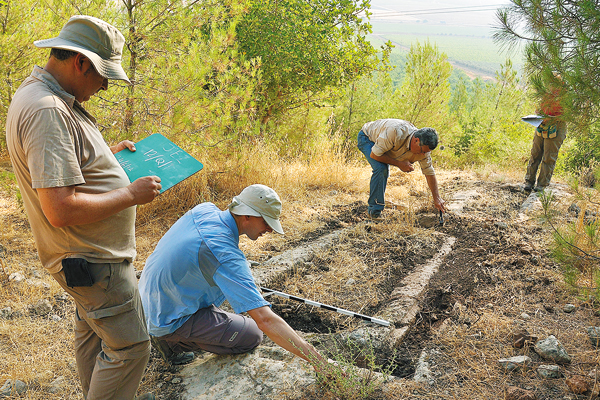

The site of Jezreel, where Queen Jezebel was thrown to the dogs (2 Kings 9:30–37), has already been excavated—and described for BAR readers.a So why are we going back?
The excavation in the early 1990s by David Ussishkin and John Woodhead (of Tel Aviv University and the British School of Archaeology in Jerusalem, respectively) produced exciting results, but we believe that there is much more to be learned. So we are organizing a new excavation.
Although Jezreel is a tell, or mound, it is not like the classic tells, such as Megiddo, Hazor or Rehov with layer upon layer (or strata) from different time periods. Instead, Jezreel is a rocky hilltop site where ancient architectural remains have not been well preserved in most areas. The builders of the Iron Age (Biblical period) enclosure appear to have cleared much of the site prior to construction. And later inhabitants of the site, up to and including the villagers of the nearby Ottoman-period settlement called Zerin (a name with an echo of Jezreel), continually robbed the ancient settlement and reused the stone masonry in their own construction, leaving little if anything on the mound.
But there is more to Jezreel than just this hilltop site. In fact, Jezreel appears to consist of two sites, perhaps not physically connected but almost certainly politically connected. The other site, the Spring of Jezreel (1 Samuel 29:1), also known as Ein el-Meita, or “dead spring” in Arabic, is located a half mile northeast of the summit site and is 1.5 feet below sea level. It was the spring of Jezreel. It was Jezreel’s life blood, a constant source of water that ensured Jezreel’s occupation continuously from the late Neolithic (c. 5000 B.C.E.) to the 20th century C.E.

The spring is dependent on the Gilboa mountain range aquifer, and its flow during various historical times has been irregular, probably giving rise to its Arabic name. In ancient times, however, the spring appears to have had a larger and steadier output, as attested by its prominent role in the Biblical narrative (1 Kings 21; 2 Kings 9).
We intend to explore thoroughly the area of the Spring of Jezreel. But there is still more. Directly below the tell in the north is an unexcavated terrace. This basalt terrace, covered with a deep and fertile alluvial deposit, slopes down gradually, from 130 feet to 30 feet above sea level. It overlooks the Spring of Jezreel, separated from it by an outcrop of large basalt boulders. Half a century ago, a local archaeologist named Nehemiah Zori investigated this area and reported remains from the Neolithic, Chalcolithic, Early Bronze, Iron, Persian, Hellenistic and Byzantine periods.
What was the connection between the spring and terrace, on the one hand, and the tell, on the other? Were they separate sites or was there one large site spread over a wide area? If separate, how did they relate?
To answer questions like this, in February 2012 we commissioned a LiDAR (Light Detection and Ranging) scan over an area of nearly 3 square miles of “greater Jezreel.” The LiDAR scan is aligned and calibrated with a permanent Global Positioning System (GPS) station and provides us with highly accurate location and height data. The LiDAR scan gives us high-resolution digital elevations of the site, revealing the micro-topography otherwise hidden by vegetation. This is a kind of “instant virtual deforestation” that can be examined for historic and natural features. This is the first time that airborne LiDAR has been used by an archaeological project in Israel.
Then in June 2012, armed with a handheld GPS unit, cameras, chalkboards and keen student surveyors, we moved through the thick undergrowth covering the area to explore and record visible features on the ground. Braving barbed-wire fences, cactus thickets, open cisterns and potentially dangerous caves and tombs, we examined areas of “greater Jezreel” that have been neglected in the past, especially the north-facing slope that runs down from the tell to the alluvial terrace and an uncultivated rocky area immediately overlooking the spring.
In just a few weeks we discovered 361 features, the majority of which had never been documented, including 25 cave tombs, 35 rock-cut tombs, 57 agricultural installations, 21 ancient quarries, 94 walls of unknown date, 26 natural caves that had been adapted for animal use, and nearly 100 cisterns.
The rock-cut trough tombs and cave tombs will help us understand the limits of the settlement in different periods, since burials were always extra-mural, or located outside the settlement area. The agricultural installations ranged from small cup marks to large oil and wine presses, including one that may belong to the time of Naboth’s orchard, which Jezreel’s husband Ahab coveted and for which Jezebel had Naboth framed and executed (1 Kings 21).
Our landscape survey has already revealed that Jezreel is much larger than previously understood. And we are just beginning. One intriguing area of further investigation will be the terrace, particularly the area overlooking the spring. Building remains that we could not see on the ground because of the dense overgrowth showed up on the LiDAR scan there, suggesting architectural remains just below the surface.
All this new information taken together already seems to suggest that there was a lower city of Jezreel, in addition to the rather enigmatic Iron Age enclosure exposed in the 1990s dating to the period of Naboth, Ahab and Jezebel.
What was the lower city like? And when was it inhabited? And how far did it extend? Stay tuned. Or, better yet, join us at the dig.
MLA Citation
Footnotes
David Ussishkin, “Jezreel—Where Jezebel Was Thrown to the Dogs,” BAR 36:04.

